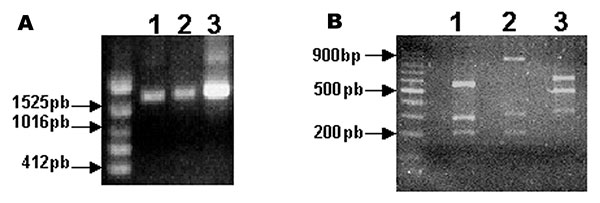Volume 9, Number 2—February 2003
Research
Araçatuba Virus: A Vaccinialike Virus Associated with Infection in Humans and Cattle
Figure 3

Figure 3. Detection and restriction fragment length polymorphism taxonomic analysis of the Araçatuba virus ATI gene. Primers based on the ATI gene nucleotide sequence from the cowpox virus were used to amplify the gene. (A) The amplified fragments were resolved on 0.6% agarose gel with ethidium bromide. Line 1 shows Araçatuba virus; line 2 shows vaccinia virus; and line 3 shows cowpox virus, Brighton strain. (B) Products obtained after amplification were digested with XbaI restriction enzyme. Fragments were resolved on 1.5% agarose gel stained with ethidium bromide. Arrowheads indicate molecular sizes (line 1, Araçatuba virus; line 2, vaccinia virus; line 3, cowpox virus, Brighton strain.
Page created: December 07, 2010
Page updated: December 07, 2010
Page reviewed: December 07, 2010
The conclusions, findings, and opinions expressed by authors contributing to this journal do not necessarily reflect the official position of the U.S. Department of Health and Human Services, the Public Health Service, the Centers for Disease Control and Prevention, or the authors' affiliated institutions. Use of trade names is for identification only and does not imply endorsement by any of the groups named above.